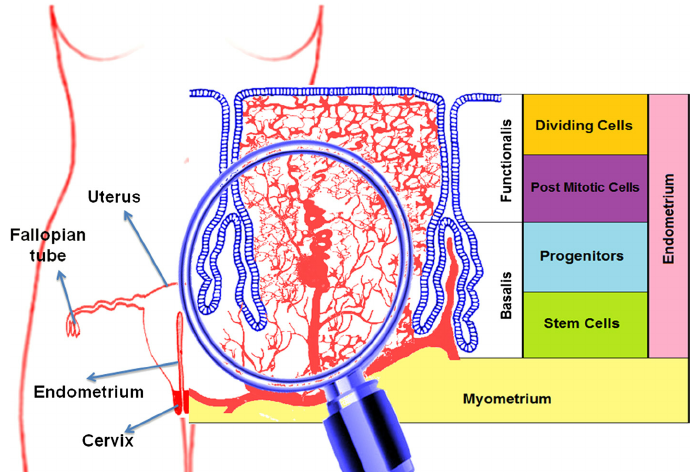|
|
Lack of stem cells causes recurring miscarriages
Scientists at the University of Warwick have discovered that a lack of stem cells in the womb lining is causing thousands of women to suffer from recurrent miscarriages.
Miscarriage is the most common cause of pregnancy loss. Between 15-25% of pregnancies end in miscarriage. One in 100 women trying to conceive suffer recurrent miscarriages, defined as the loss of three or more consecutive pregnancies. Researchers examined tissue samples from 183 women with recurrent miscarriages, who were being treated at the Implantation Research Clinic, University Hospitals Coventry and Warwickshire National Health Service (NHS) Trust in the United Kingdom (UK).
They found an epigenetic signature - the attachment of a histone group which is typical in stem cells - was missing in cultures grown from biopsies of these wombs. Fewer stem cells were isolated from the lining of the wombs of recurrent miscarriage patients than from women with full term pregnancies in the study's control group.
The study was a collaboration between the University's Warwick Medical School and Warwick Systems Biology Centre, and is published in the journal Stem Cells.
"We discovered that the lining of the womb in recurrent miscarriage patients, is already defective before pregnancy.
Jan Brosens PhD, Professor of Obstetrics & Gynaecology, Warwick Medical School (WMS), department of Reproductive Health, University of Warwick, Coventry and team leader.
Professor Brosens adds: "After an embryo has implanted, the lining of the uterus develops into a specialised structure called the decidua. This process can be replicated from cultured uterine cells in the lab.
"Cultured cells from women who had had three or more consecutive miscarriages showed that ageing cells in the lining of the womb don't have the ability to prepare adequately for pregnancy."
Uterine lining has to renew itself with each menstrual cycle, after each miscarriage and after each successful birth and depends on a resident stem cell population. A shortage of stem cells in patients suffering recurrent loss is associated with accelerated womb ageing.
Ageing cells mount an inflammatory response — which may facilitate implantation of an embryo — but is detrimental to further embryo development.
"The real challenge now is to develop strategies to increase the function of stem cells in the womb lining.We will start piloting new interventions to improve the lining of the womb in the spring of 2016.
"Our focus will be two-fold. First, we wish to improve the screening of women at risk of recurrent miscarriage by developing new endometrial tests.
"Second, there are a number of drugs and other interventions, such as the endometrial 'scratch', a procedure used to help embryos implant more successfully, that have the potential to increase the stem cell populations in the womb lining."
Siobhan Quenby PhD, Professor of Obstetrics, University of Warwick, and Honorary Consultant at University Hospital Coventry and Warwickshire NHS trust, co-author of study.
Abstract
Menstruation drives cyclic activation of endometrial progenitor cells, tissue regeneration, and maturation of stromal cells, which differentiate into specialized decidual cells prior to and during pregnancy. Aberrant responsiveness of human endometrial stromal cells (HESCs) to deciduogenic cues is strongly associated with recurrent pregnancy loss (RPL), suggesting a defect in cellular maturation. MeDIP-seq analysis of HESCs did not reveal gross perturbations in CpG methylation in RPL cultures, although quantitative differences were observed in or near genes that are frequently deregulated in vivo. However, RPL was associated with a marked reduction in methylation of defined CA-rich motifs located throughout the genome but enriched near telomeres. Non-CpG methylation is a hallmark of cellular multipotency. Congruently, we demonstrate that RPL is associated with a deficiency in endometrial clonogenic cell populations. Loss of epigenetic stemness features also correlated with intragenic CpG hypomethylation and reduced expression of HMGB2, coding high mobility group protein 2. We show that knockdown of this sequence-independent chromatin protein in HESCs promotes senescence and impairs decidualization, exemplified by blunted time-dependent secretome changes. Our findings indicate that stem cell deficiency and accelerated stromal senescence limit the differentiation capacity of the endometrium and predispose for pregnancy failure. Stem Cells 2016;34:346–356
The University of Warwick has been selected to be a partner in the largest miscarriage research centre in Europe. Funded by the leading pregnancy charity, Tommy's, the University's researchers will be joining doctors from University Hospital, Coventry to investigate the causes of early miscarriage. The research centre will open in April 2016.
The research was funded by the Genesis Research Trust and the Biomedical Research Unit in Reproductive Health, a joint initiative between Warwick Medical School and University Hospitals Coventry and Warwickshire NHS Trust.
Return to top of page
|
|
|
Mar 11, 2016 Fetal Timeline Maternal Timeline News News Archive

One in 100 women trying to conceive suffer recurrent miscarriages,
defined as the loss of three or more consecutive pregnancies.
Image Credit: Research Gate
|
|
|
|



